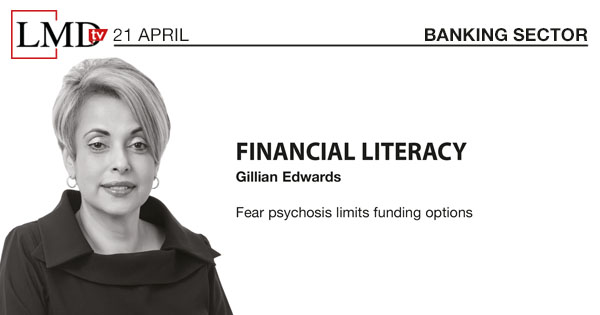LMD TV
 “The SME sector is still reeling from the outcome of the storm,” stated banking sector veteran Gillian Edwards, referring to the consecutive disasters that struck the economy since the natural calamities of 2016/17, followed by the 2019 Easter Sunday attacks, which catapulted into the arms of the pandemic so to speak.
“The SME sector is still reeling from the outcome of the storm,” stated banking sector veteran Gillian Edwards, referring to the consecutive disasters that struck the economy since the natural calamities of 2016/17, followed by the 2019 Easter Sunday attacks, which catapulted into the arms of the pandemic so to speak.
According to Edwards, the impact of the pandemic on tourism has had a “domino effect on the whole economy” due to the interconnectedness of the industry and multiple other sectors. Thereon, she highlighted the apparel industry – especially the struggles experienced by small and micro businesses that rely on subcontractors.
“These micro businesses were the most affected because they lost the entire April season. With nowhere to sell their products, they wound up their businesses and bore the brunt of unemployment,” Edwards asserted.
On a positive note, not all sectors staggered to such an extent. Among those that thrived were agriculture, fisheries, the wholesale and retail trade, FMCGs, healthcare, IT and telecom.
“Sri Lanka has gone through a rocky road but we will bounce back,” she remarked, strongly believing that the country was on the road to recovery at the time of this interview for LMDtv.
A number of government-funded relief facilities materialised in parallel with funding lines provided by banks, which were oriented towards propping up the SME sector. “The majority of the small and micro entrepreneurs lack financial literacy,” said Edwards.
According to her, this is a vital skill for entrepreneurs to master. As most of the micro businesses are managed by those with basic school education, the level of understanding they display in areas such as budgeting, planning and fund management is mediocre.
The ability to manage risks – and knowledge of interest rates, contingency funding and insurance – are among the other important skills that small and micro businesses lack. “This makes them vulnerable when they seek funding as they prefer to borrow from the informal sector with no consideration for interest costs,” she noted.
Micro businesses fear reaching out to banks because they have a notion that banking institutions will resort to foreclosing their collateral. Most of them do not seek loans. As for the banks, it’s difficult to reach out to these businesses as 75 percent reside in rural areas.
In addition to this, they’re devoid of proper bookkeeping systems; therefore, financial records are not available when they choose to apply for loans. Keeping money at home instead of at the bank is another disadvantage as they do not have bank statements as proof of income.
Aside from bestowing them with sufficient financial knowledge through government support and other awareness programmes via the banking sector, Edwards cited the following steps to achieve entrepreneurial success: business planning, feasibility studies, knowing where to source raw materials and labour from, and marketing.
“This is a two-way street,” said Edwards, “where both entrepreneurs and other stakeholders such as the authorities and banks must work together.” To this, she added: “We need an attitude change – to stop believing that locally made products are of inferior quality.”
She highlighted the value of an attitudinal change – i.e. to be proud about buying, wearing and consuming goods manufactured in Sri Lanka. And in the face of import restrictions, local producers have had the opportunity to grow.
Furthermore, Edwards mentioned how the government-funded Saubagya Loan Scheme, which enabled businesses to borrow at four percent with a 24-month repayment period, kick-started the lending spree for private sector credit.
Edwards concluded: “SMEs – especially in the rural communities – require handholding. To facilitate this, a hybrid working model is necessary.” The older generation still prefers bricks and mortar branches while younger entrepreneurs opt for digital services, she added.



